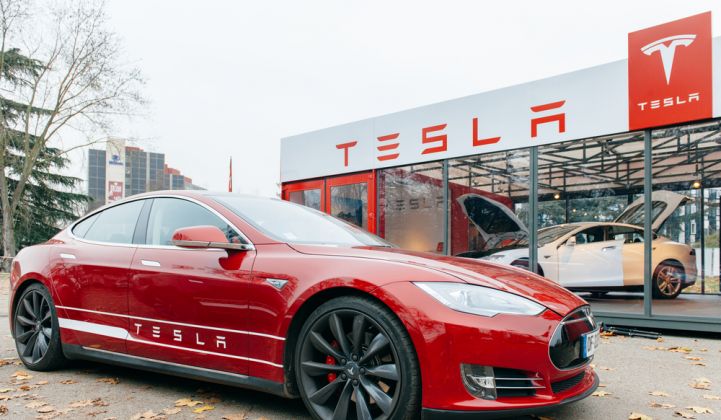Earlier this week, it looked like Wall Street’s love affair with Tesla Motors was coming to an end. The company's stock price was down 40 percent from the start of the year, as analysts expressed concern over its ability to affordably scale up production.
On Wednesday, Tesla reported its fourth-quarter earnings showing a non-GAAP net loss of $114 million, or 87 cents per share -- which was far worse than analysts expected. According to Thomson Reuters, analysts were expecting earnings of 10 cents per share.
Tesla took an even bigger hit on a GAAP basis, losing $320 million, or $2.30 per share.
And yet, the Silicon Valley electric-vehicle maker saw its stock go up 10 percent in after-market trading as CEO Elon Musk pledged ambitious growth for 2016. Tesla set a target of 80,000 to 90,000 vehicle deliveries this year, up from 50,000 deliveries last year, and 32,000 the year before.
“Tesla is approximately doubling its cumulative sales every year,” said Musk on a post-earnings conference call. “I think that’s pretty exciting and unusual.”
Musk said his company also aims to be net cash flow positive by March, and achieve non-GAAP profitability in 2016. This outlook comes as Tesla plans to invest $1.5 billion to support cell production at the Gigafactory, open 80 new retail stores, build 300 new supercharger locations and set up production for the Model 3 mass-market EV.
Tesla heads into the year with some momentum. In Q4, the company generated $179 million in positive cash flow, and ended the quarter with global Model S deliveries up 76 percent year over year. The Model S was the best-selling premium sedan of any kind in the U.S. last year, showing a substantial sales increase, while all other premium brands saw sales declines and the overall market contracted by 1 percent.
Demand for the Model S “represents a microcosm of how Tesla vehicles will be received in other vehicle segments,” said Musk. “It bodes extremely well for the future.”
Tesla executives underscored that the Model 3 is on track to be introduced on March 31, and will begin production and deliveries at the end of 2017. Earlier this week, Musk confirmed the Model 3 will sell for $35,000, which means consumers could pay as little as $25,000 after federal and state incentives. The price tag beats the recently unveiled GM Bolt, although the Bolt will hit the market roughly a year before the Model 3.
Ahead of the earnings call, analysts expressed concerns that Tesla would have trouble ramping production of the highly anticipated Model X SUV. They also questioned Tesla’s ability to roll out the Model 3 on schedule and achieve sales targets as gas prices linger at record lows.
Musk has pledged to deliver 500,000 vehicles per year by 2020, with the Model 3 driving much of that growth. Morgan Stanley’s Adam Jonas, a longtime Tesla bull, recently said he’s not convinced Tesla can hit that target. Jonas said he thinks the EV maker may only be able deliver 246,000 vehicles per year by the end of the decade.
"Low demand for electric vehicles categorically and globally in a $30 oil environment leads us to reduce volume assumptions for the Model 3," Jonas wrote.
Tesla execs dismissed concerns around low oil prices, claiming they haven’t seen any affect on demand to date. They also sought to quell concerns over continued losses.
According to the investor letter, “capital expenditures were primarily for the capacity expansion and tooling associated with Model X, construction of the Gigafactory, and expansion of service centers, retail locations and the Supercharger network.”
Tesla’s new CFO, Jason Wheeler, former VP of finance at Google, said it was now his singular focus to rein in operating costs and find ways to drive down costs on the vehicles, through better manufacturing and improved reliability.
“Cash is king,” he said.
Musk assured analysts several times that production of the Model X is now on track, and that technical glitches, some as mundane as issues with the door seals, were firmly behind them. By the second quarter, Tesla will be able to produce an average of 800 Model X units per week.
The CEO acknowledged that the past few months have been “quite excruciating,” noting there had been many late work nights and busy weekends. With the Model X, the problem was trying to fit too many great things into one product, but the effort will prove worth it, he said.
“The net result is that the Model X is an amazing car,” said Musk. “I think it’s the best car ever. […] I’m not sure anyone would make a car like this again. I’m not sure Tesla would make a car like this again.”



